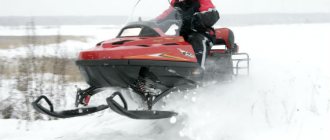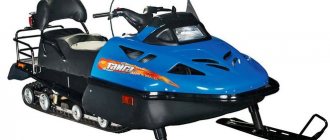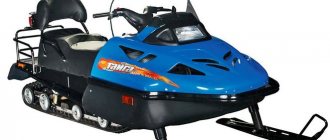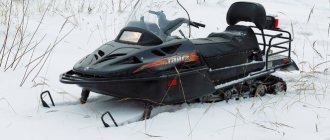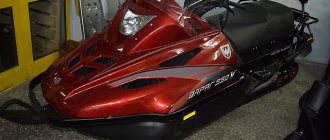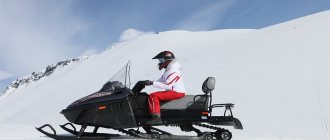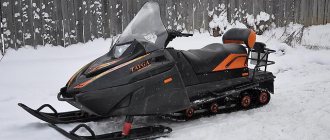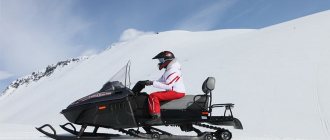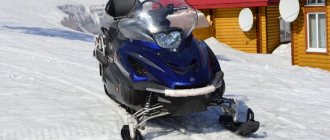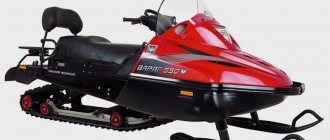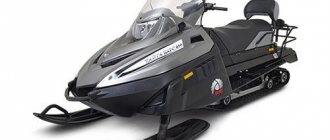Taiga Attack 2 is a domestic snowmobile with a promising future. This is not a new car, but it is relevant and time-tested. Of course, the device is not equipped with innovative technologies that would negatively affect the popularity of the snowmobile, which is designed for a mass audience. The main advantages of the device in question are its simplest design, proven technical solutions, affordable components and high maintainability. It must be admitted that the Taiga Attack 2 model often turns out to be more effective than more modern snowmobiles - at least from the point of view of ease of maintenance in the field, as well as cross-country ability.
And yet, the developers of the Taiga Ataka 2 snowmobile did not focus only on maintainability and simplicity of design. Experienced engineers with Soviet experience went further and carried out several successful upgrades that affected almost all the technical parameters of the Taiga Attack 2 snowmobile. Of course, with all the modifications, the machine retained the successful technical solutions borrowed from its predecessors. The Taiga Ataka 2 device, developed by specialists, rolled off the assembly line of the Rybinsk Motors enterprise, located in Rybinsk.
By modifications we mean the release of various modifications of the Taiga Attack 2 snowmobile - the manufacturer came to the conclusion that this would make it easier for the consumer to decide on the right snowmobile, adapted to certain needs. But all modifications are united by reliability and directional stability, as well as a long service life in difficult natural areas - for example, in the northern regions of the Russian Federation. Also, such important parameters as controllability, maneuverability, speed characteristics and resistance to damage when hitting hard objects were not neglected. For these purposes, it was enough to use a chassis consisting of one central track and two front skis.
Advantages and disadvantages
Examples of positive reviews for the Taiga Ataka 551 snowmobile:
- “Excellently passes through snowdrifts under 2 meters” (Vladimir, Altai Territory)
- “I’ve been using this snowmobile for hunting for 3 years now, not a single breakdown” (Evgeniy, Omsk)
- “This is my third snowmobile, but Taiga Ataka has the most comfortable fit and stability on loose snow” (Serega, Voronezh)
- “It starts in cold weather with half a turn. The steering qualities are excellent, no bumpiness when driving” (Ivan, Tyumen).
- “It maneuvers well in the forest, even in deep snow” (Leonid, Rybinsk).
- “Compared to the Yamaha that I had before, repairs are rarely needed and parts cost pennies; they are always easy to find on Drom and Avito” (Denis, Novosibirsk).
Examples of negative reviews from owners of the Taiga Ataka II 551 snowmobile:
- “For domestic equipment the price is a bit high, even a used one costs as much as a new Buran, which I like better” (Alexander, Krasnoyarsk Territory).
- “2.5 liters of oil per 100 km is a bit much. The Varyag 550 v has one tank for 120 km” (Dima, Moscow).
- “I don’t like the appearance and it gets very hot in heavy snow, so I had to tune the hood myself and improve the cooling” (Timur, Perm region).
- “The handles on the back seat are annoying - because of them you can’t lift the seat or put something oversized back” (Vladimir N., St. Petersburg).
- “The Attack snowmobile suits me, but snow constantly gets under the seats.”
- “It runs well at temperatures down to -30 degrees, if lower, it won’t start right away. And we actually have harsh winters. And changing the oil too often, of course, is very annoying” (Roman, Novosibirsk).
- “It doesn’t develop speeds above 7000. And after traveling 800 km, the starter broke and the glass cracked. I spent a long time looking for a repairman in my area, no one wanted to tinker with Taiga” (Semyon, Bashkortostan).
Appearance
The design has a masculine character - it has quite aggressive sporty details, and is presented in strict black or bright red. A fairly high windshield is installed in front, although it is quite narrow, unable to protect from snow during side gusts of wind.
The instrument panel is minimalistic. It consists of an analogue (pointer) speed sensor and a fuel sensor, warning lamps - everything is assembled in a single housing. All lights and control lights are made using LEDs.
The body is made of impact-resistant ABS plastic, which has proven itself well in test drives. The seat is double (for the driver and one adult passenger), quite soft, but not “sagging”. The back of the snowmobile has a backrest and small side rails that the passenger can hold on to while riding.
Overview of the device and equipment
Taiga Attack belongs to the touring class of snowmobiles, so it is strange to expect heavy-duty filling from it - it is just enough to carry out safe and smooth off-road riding for entertainment purposes. If you use it for extreme and sports driving (making high jumps, intentionally crashing into obstacles, trying to drive through water, etc.), then the equipment will quickly fail. For utilitarian purposes, a snowmobile is ideal.
Engine RMZ 551
The RMZ 551 motor, as supplied by the manufacturer, is only a two-stroke two-cylinder. A 4t engine can be available when purchasing a Taiga Ataka 551 II snowmobile after modification (for example, after installing a “non-native” power unit from Daewoo Matiz, Taiga Patrul or Lifan). Power unit power - 65 horsepower; volume – 553 cm³. The snowbike accelerates to 110 km/h. The engine is “hidden” under the hood (just lift the cover and you will have access to any component).
Japanese Mikuni carburetors are responsible for the reliability of the power system, and Ducati programmable CDI ignition is responsible for stable operation. The separate lubrication system of a two-stroke engine ensures timely application of material to all components of the snowmobile's power system. In addition, economical use of the product is ensured due to high dosing accuracy.
Fuel system
The capacity of the oil tank is 2.5 liters. The volume of the fuel compartment is 40 liters. Both tanks are placed in a bracket on the snowmobile frame. The neck is equipped with a lid with a liquid level indicator inside.
The car's fuel consumption is moderate. For 100 km when driving on trampled snow at a speed of about 30 km/h, Taiga Attack 2 will consume 24 liters. If you add a maximum load, the consumption will increase to 26 liters.
Why is there a receiver in Taiga Attack?
The snowmobile is equipped with a receiver K20500030. It was not installed on the 1st generation Taiga Attack; instead, the pipes were connected with a simple hose. The receiver is designed to stabilize pressure, smooth out air pulsation and increase the service life of parts.
Transmission
The Taiga Attack 2 has a V-belt variator and gearbox. The shift lever is on the left and has 4 positions: neutral, first gear, second gear and reverse. The variator is manufactured at . But the belt is an American Xtreme model with a Kevlar cord base. Size: 35x14x1118mm. The belt has high strength, wear resistance and allows for instant response when accelerating.
Suspension
The propulsion unit includes a gooseneck, a drive shaft with wheels and a sliding rail suspension. The rear suspension has 2 pneumatic-hydraulic shock absorbers, which smoothes out the ride over uneven surfaces. Its stroke is 370 mm. The suspension adjustment is ratchet.
The front suspension is lever type with a travel of 205 mm. Its advantage is easier control of the car during a forced snowmobile jump.
Snowmobile track Taiga Attack 2
Dimensions of the track from the snowmobile Taiga Attack 2 – 3937×500×22 mm. The number of steps is 62. The Composite Tract tape is characterized by reinforced load hooks (from heights of 22.5 mm). It is also distinguished by a wide track, which provides confident grip on the surface and good maneuverability of the snowmobile in deep snow.
If the tape is damaged and you cannot find the original part (Taiga 500 ICE) - no problem. For this snowmobile you can buy a COMPOSIT BEAVER WT track.
What are slicks suitable for?
The manufacturer uses a BLACK SLIDE made of lightweight plastic for the Taiga Attack. They are made in Canada (from Camoplast). They glide well, but, unfortunately, they often crack. If necessary, they can be replaced with any slip with number C40200503 (for example, from BRP Ski-Doo, Lynx snowmobiles).
Brake system
The Taiga Attack 2 has a hydraulic disc brake. It has such advantages as the absence of backlash. Thanks to hydraulics, the accuracy of braking force control and the immediate removal of the pads from the disc when the handle is released increases. The disadvantages include high cost (a fully assembled brake structure costs from 9,900 rubles) and a design unsuitable for repair in the field.
Steering
The snowmobile's handling is intuitive and responds well to the slightest turns. The motorcycle-type handlebar is rigidly connected to the steering shaft, which is increased by 80 mm (compared to previous Taiga models). The basic package includes a protective cover, heated grips and gas trigger.
Cooling system
The cooling system in Taiga Attack is liquid. Compared to its air counterpart, it allows you to increase power by 10% without excessive overheating. The only thing is that users make complaints about an increase in temperature when working at above-zero air temperatures on ice and crust without powder snow. In this case, many decide to bleed the cooling system - for example, to provide a snowmobile forcibly cooled by an air flow from an electric fan. For ease of control, it can be equipped with a separate toggle switch.
It is important to observe the filling volumes of the cooling system: the minimum level of antifreeze should be 1/3 of the tank, the maximum – 2/3 of the tank (check on a cold engine). The coolant in Taiga Ataka 2 is a mixture of Febi 02374 concentrate (60%) and distilled water or SWAG 99 90 2374 (40%).
Transmission unit
The power unit transmits torque to the propulsion mechanism using a continuously variable variator. This element has several operating modes: neutral, reverse, low and high range. Unlike a traditional gearbox, this design increases the working life of the motor, guaranteeing its optimal operation.
Despite the apparent perfection of the system, it is precisely this system that often causes complaints from owners. The parameters of the springs and weights of the unit do not always equal the design characteristics. You can improve the performance by adjusting the parts yourself. In general, the intended system, when working correctly, is very convenient and productive, which is good news.
Operation and repair manual
A new snowmobile must first be prepared as described in the instructions (remove external lubricant, install ski undercuts, brackets, windshield, etc.). The next step is to fill the brake fluid, oil, and fuel into the tanks. For refueling it is better to use 92 gasoline.
It is important to break in the vehicle. For Taiga Attack 2 it is 300 km. During break-in, you should not carry passengers or cargo (that is, you should give the minimum load). Also avoid bumpy roads and drive on flat roads with dense snow. Leave riding on rough terrain, deep loose and wet surfaces until the break-in is completed. Short-term accelerations and changes in speed are allowed to check the functionality of the power and chassis of the snowbike. After driving 150 km, be sure to check the tension of the fan belt and track.
It is important to maintain regular maintenance. The first should be done after breaking in the snowmobile. TO-1 is carried out every 1000 km, TO-2 - every 3000 km. It is recommended to carry out seasonal maintenance after long-term storage without use.
The engine does not develop speed: reasons and what to do
| Cause | Repair |
| Spark plugs are faulty | Remove carbon deposits; if the spark plugs are completely faulty, replace them. |
| Fuel does not go to the engine | Check the fuel level and filter cleanliness. Replace the faulty pump. |
| Compression is insufficient | Adjust the tightening of the spark plugs, check the integrity of the crankshaft seals and the cylinder head gasket. |
The power unit is heating up: how to fix the problem
The most common problem that requires a mechanic to repair an engine is related to excessive overheating. You can correct the situation in the following ways:
- Inspect the spark plugs; if carbon deposits are present, it must be cleaned off or the spark plugs replaced with new ones.
- Test the engine for leaks (the test is carried out by entering compressed air into the intake manifold at the initially set pressure). Inspect the gaskets for damage and check the crankcase for leaks, replace the faulty ones.
- Check the quality of the oil (color test - it should not be too dark). Due to the use of a defective product, the bottom of the piston will burn out and melting will occur at the annular gap.
- Inspect the piston for grooves. They will occur if snow gets into the engine and damages the fuel film. The problem is solved by completely replacing the piston.
- Check the exhaust system, inspect for carbon deposits (it contributes to narrowing). If you find it, you need to clean the surfaces.
- Check the fan belt. Weak belt tension leads to engine overheating and constant slipping.
What to do if the cooling system is airy
The cooling system will not function properly if air bubbles have accumulated in it. To remove them, you need to:
- Warm up the engine for 10 minutes and turn it off.
- Remove the pipes on the assembly with the expansion tank cap closed.
- The antifreeze circulation circuit is activated and it will begin to flow out little by little.
- Drain the antifreeze (a couple of drops) and return the tube to its place, secure it tightly with a clamp.
Carburetor adjustment
After checking the general technical condition of the engine and power system, the carburetor is adjusted. The following requirements must be met on the RMZ-551 engine:
- The needle lock should be in the third groove when using the snowmobile in sub-zero temperatures, the idle screw should be turned one turn.
- When using Taiga Ataka 2 in warm weather, the needle lock is moved to the second groove, the idle screw is turned 1.5 turns.
Adjusting the variator
For stable operation of the snowmobile, it is necessary to adjust the variator - ensure that the following requirements are met:
- the distance between the pulleys should be 2.71 cm;
- the gap between the ends of the drive and driven pulley disks is less than 1.4 cm;
- the spring of the variator driven pulley should be tensioned to 6.5 kgf.
How to remove the variator
To remove the variator yourself, you can use the instructions from the video:
To remove the belt, you need to hold the parking brake, remove the casing and spread the driven pulley discs. Then you need to press the movable disk away from the stationary one by turning it clockwise and throw the belt over the edge.
Change of oil
An oil change is needed if poor quality is detected (for example, a couple of drops taken for testing are too dark and have foreign impurities). It is also necessary to drain the fluid during seasonal storage, when the snowmobile is not planned to be used for a long time.
The old oil in the box can be pumped out through the dipstick neck or drained through the plug at the bottom of the engine. After the fluid has been removed, wipe the engine with a rag.
To refill the snowmobile's oil tank, use TAIGA-2T, ECoil-2T-ARCTIC or BOMBARDIER FORMULA XP-S. It is recommended to add a small amount of FENOM “Nano Metal Conditioner”. Filling volume - 2.4 l. When filling, it is important to ensure that there is at least 15 mm between the oil level and the neck of the tank.
How to drain antifreeze
Antifreeze is drained according to the standard scheme:
- Place a container under the drain hole to collect the antifreeze.
- Wait for the snowmobile to cool completely.
- Unscrew the cap of the expansion tank and radiator.
- Unscrew the locking bolt on the engine (without this, the antifreeze will not come out completely).
- Unscrew the lower radiator cap.
Always pay attention to the color of the drained antifreeze. If it is black, then the entire cooling system needs to be flushed. This is done with a special technical fluid - it is poured in and heated to operating temperature. Then the snowmobile is drained, cooled, and only after that new antifreeze is introduced.
Radiator installation
An overheating engine may indicate problems with the radiator. If it becomes clogged, simple cleaning will be required. If damage occurs with depressurization followed by leakage of antifreeze, then installation of a new radiator is required. In workshops, the service costs 2200-2500 rubles. Installation proceeds as shown in the video:
How to replace engine mounts
To remove the damaged part, you need to remove the fastenings; the engine will tip over a little, this is normal. The next step is to remove the worn-out cushion (it may resist a little, but you still don’t need to pull too hard so as not to damage adjacent parts). Now we need to install a new pillow. Apply lubricant on top and then secure the bolts.
How to turn off the speedometer
If you suddenly want to turn off the speedometer, then just remove the speed sensor. It is located under the variator. You need to disconnect two bolts, after which the sensor can be easily removed over the wires. The procedure is typical for all types of snowmobiles, here, for example, is how it is done on a Yamaha (on Taiga, removing the sensor is done according to a similar scheme):
How to adjust the suspension
Depending on the weight of the cargo you are going to transport, as well as the weight of the driver, driving speed and road conditions, you need to adjust the rear suspension. The springs should be adjusted so that when fully seated (driver, passenger and/or maximum load) the rear of the snowmobile will drop no more than 60-70 mm.
To adjust the belt limiter, you must first start the snowmobile and drive it at low speed. Then you should sharply press the gas lever all the way to accelerate the snowmobile. If you feel excessive reinforcement on the steering wheel, then the bolt should be moved to the lower position, increasing the tension of the tape. If the skis are raised, then the gain should, on the contrary, be reduced by moving the bolt to the upper position.
Snowmobile tuning
Taiga Attack 2 allows for many modifications. In addition to painting, you can:
- Strengthen the bumper. Sidewalls cost from 9,000 rubles. and higher. Front bumper – from RUB 3,600; rear – from 4500 rub.
- Place cases and bags, fastenings (for example, for weapons or fishing rods). They cost between 7,000-10,000 rubles.
- Install the winch. Costs 9000-12000 rubles.
- Strengthen your defense. A kit for such tuning will cost 13,500-16,000 rubles. Luxury options cost from 35,000 rubles.
- Ski extensions. costs approximately 1350 rubles.
- Additional pump (to reduce heat during high load). Price - 3000 rub. and higher.
The snowmobile can also be equipped with an audio system. It will cost between 4500-6000 rubles.
Reasonable criticism
Reviews from motorcycle owners who have already used the popular model of Russian Mechanics JSC say the following:
- The energy-intensive suspension has good reliability. It allows you to move confidently and comfortably where cars with less advanced chassis have serious problems.
- The acceleration dynamics, despite the fairly high maximum speed, leave much to be desired. The rather large weight of Taiga Attack 2 has its effect. Still, 320 kg of dry mass is a lot. This modification should not be chosen by those who intend to go mountain freeride.
- The placement of controls cannot be called too successful. You have to get used to it and, anyway, sometimes difficulties arise.
- Snow radiators do not work well. This becomes especially noticeable when driving on ice and hard crust, when the tracks do not throw snow onto the heat exchangers. This is a property of all cooling systems of this type. In this regard, on forums there are often descriptions of how to install a radiator with an electric fan.
In a word, there is no limit to perfection, but the developers of Russian Mechanics JSC clearly have ways to improve their brainchild.
How much does it cost, where to buy new and used
The new Taiga Attack 2 costs 380,000-399,000 rubles. It is sold in any motorcycle showroom that is a dealer. Users greatly reduce the price for used snowmobiles, here are examples of offers from different countries and cities:
- Announcement from Kazakhstan: a 2011 snowmobile in excellent condition is being sold for 259,000 rubles.
- Offer from Yekaterinburg: a snowmobile from 2013, little used - sold for 280,000 rubles.
- A seller from Moscow is offering a snowmobile without an engine and a muffler with a damaged front suspension for 110,000 rubles.
- Announcement from Kemerovo: a snowmobile that requires replacement of the front glass and middle roller is being sold for 248,000 rubles.
- Offer from Noyabrsk: “Taigu Attack 2” with a mileage of 6,700 km, a damaged seat and scratches on the body is being sold for 179,000 rubles.
Where can I order and buy
The snowmobile is currently out of production, but you can still purchase a model without mileage to order from official dealers. The price of a new track, in accordance with the manufacturer’s recommendations, is 399 thousand rubles. This figure is indicated on the official website, but it may be higher at an official dealer. When ordering, a person will receive a new 2016-1018 model without mileage.
On message boards you can find snowmobiles produced in 2011-2013 for 220-280 thousand rubles. Newer models will cost more than 300 thousand rubles.
Is it worth buying: comparison with competitors and conclusions
Overall, the snowmobile leaves a pleasant impression. It is worth buying for people who need to use a snow bike without too much extreme, in moderate frosts. For comparison, here are the main competitors of “Taiga Attack 2”:
- The Lynx snowmobile costs much less (RUB 102,000), but is slower and has less lifting capacity.
- Taiga Varyag 550 - has a wide track, a large fuel tank and a bright design. But this snowmobile was discontinued due to many defects (for example, the thermostat was poorly secured at the factory, which is why users had to reinstall it themselves).
- Buran A can be bought for 259,000 rubles, but under its hood there is only 34 horsepower, and it has a rather rough design, which is not to everyone’s taste.
- Taiga Patrol 800 - the track is even wider (600 mm), the fuel tank is larger, but there are 5 fewer horses than the Taiga Attack 2 and the price is slightly higher (about 419,000 rubles).
- Yamaha Viking is stronger than Taiga Attack 2, but the price is much higher (from 790,000 rubles).
- Polaris Voyager is a stylish snowmobile with elongated tracks, but the price is significantly higher than the Taiga Attack (918,000 rubles).
Thus, the Taiga Attack 2 snowmobile has decent technical parameters for its class. In terms of price, this all-terrain vehicle even beats its main competitors.
Reviews of the snowmobile "Taiga Attack"
Users in their responses highlight several features of this technique:
- A reliable and energy-intensive suspension that allows you to move where other analogues cannot.
- Speed parameters do not always provide sufficient dynamics due to the heavy weight of the machine.
- The need to get used to the placement of controls, which not all owners consider successful.
- Insufficient performance of snow radiators. This is especially noticeable when moving on ice. Many note the advantage of versions with an electric fan. In any case, the developers still have work to do.
